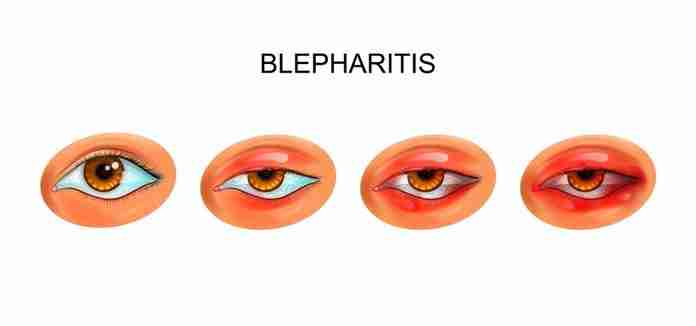Risk Factors For Blepharitis

Risk factors for blepharitis are similar to those for acne. Irritants include cosmetics, hair products, and facial creams. Some of the most common risk factors for blepharitis include: (4)
Seborrheic dermatitis
Seborrheic dermatitis is a trigger for blepharitis. It is a chronic inflammatory skin disease caused by a yeast (Malassezia) and causes red, scaly patches on the skin and sometimes yellowish or oily scales. It can affect any area of your body, including your face, eyes, groin, chest, scalp and other parts of your body.
Seborrheic dermatitis tends to occur more frequently in areas of the body with a lot of oil production, such as your scalp or face. Sebaceous glands produce oil that lubricates hair follicles and skin pores. For people with seborrheic dermatitis, this oil becomes thick and sticky due to changes in the yeast germs living on skin tissues. This clogs the openings of tiny hair follicles at the base of eyelashes. This clogging causes a buildup of dead skin cells that often form flaky yellow scales on your skin surface.
Contact allergies
Contact allergies are a common risk factor for blepharitis. The eyes are exposed to a wide variety of allergens through medications, cosmetics, household cleaners, soaps and detergents. This may include things like fragrance in face creams, dyes in eyeliner or mascara, preservatives in makeup and eye drops, and even contact lens solutions. Studies show that people who are allergic to cosmetics and chemicals (like perfume) have an increased chance of having blepharitis. These allergens cause dryness on the eyelids and skin surrounding the eyes, leading to redness, irritation and ultimately eyelid scaling.
Some people are more likely to get contact lens-related eye infections than others. If you have contact lens-related eye infections or skin allergies, you may be at greater risk for developing blepharitis.
Diabetes
Diabetes is the number one cause of seborrheic dermatitis, a condition that leads to inflammation of the eyelids and results in redness and flaking. Patients who have diabetes are more likely to develop blepharitis, according to an article published in “The Journal of Family Practice” in 2010. This may be due to increased hormones as well as an increase in bacteria on the eyelids that cause inflammation . It’s important for patients with blepharitis and diabetes to be aware of these risk factors so that they can ensure proper treatment for both conditions – though there’s no evidence that treating either one will help prevent the other from occurring.
Poor hygiene
Poor hygiene habits are the primary risk factor for blepharitis. People who do not regularly wash their face have a higher risk of developing the condition. This usually leads to bacteria accumulation on the eyelids which can lead to inflammation and irritation.
If you do not remove your contact lenses properly, or fail to wash around them regularly, this can cause bacteria to grow on your eyelashes. Other poor hygiene habits are associated with poor treatment compliance, poor wound healing, and increased bacterial resistance. Improperly shutting eyelids when sleeping, not cleaning hands before bed, or rubbing eyes with dirty fingertips can spread bacteria that cause blepharitis around the eye area.
Cosmetic makeup
Makeup for women can be quite potent. Cosmetic makeup is a broad term that encompasses many cosmetic products, including makeup, sunscreen, moisturizers and makeups. Many types of mascara, for example, contain the chemical phenylenediamine (PPD), which can cause skin reactions. In some cases, makeup may clog the pores and cause blepharitis.
The most common cosmetic products that are believed to create a risk for blepharitis are mascara, eyeshadow and eyeliner. When mascara is used it can clog the conjunctival sac. Mascara is loaded with oils, so the eyelids are more susceptible to infection.
Age
The risk of becoming affected with blepharitis rises with age. People with blepharitis are often older, because symptoms are most common in people who are 50 and older. As we age, our eyes become more susceptible to this condition and the symptoms become more severe. The risk of blepharitis may increase with age due to the fact that the eyelid shrinks, lessening the size of its opening. This can cause pressure on the eye and increased risk of bacteria growth.
